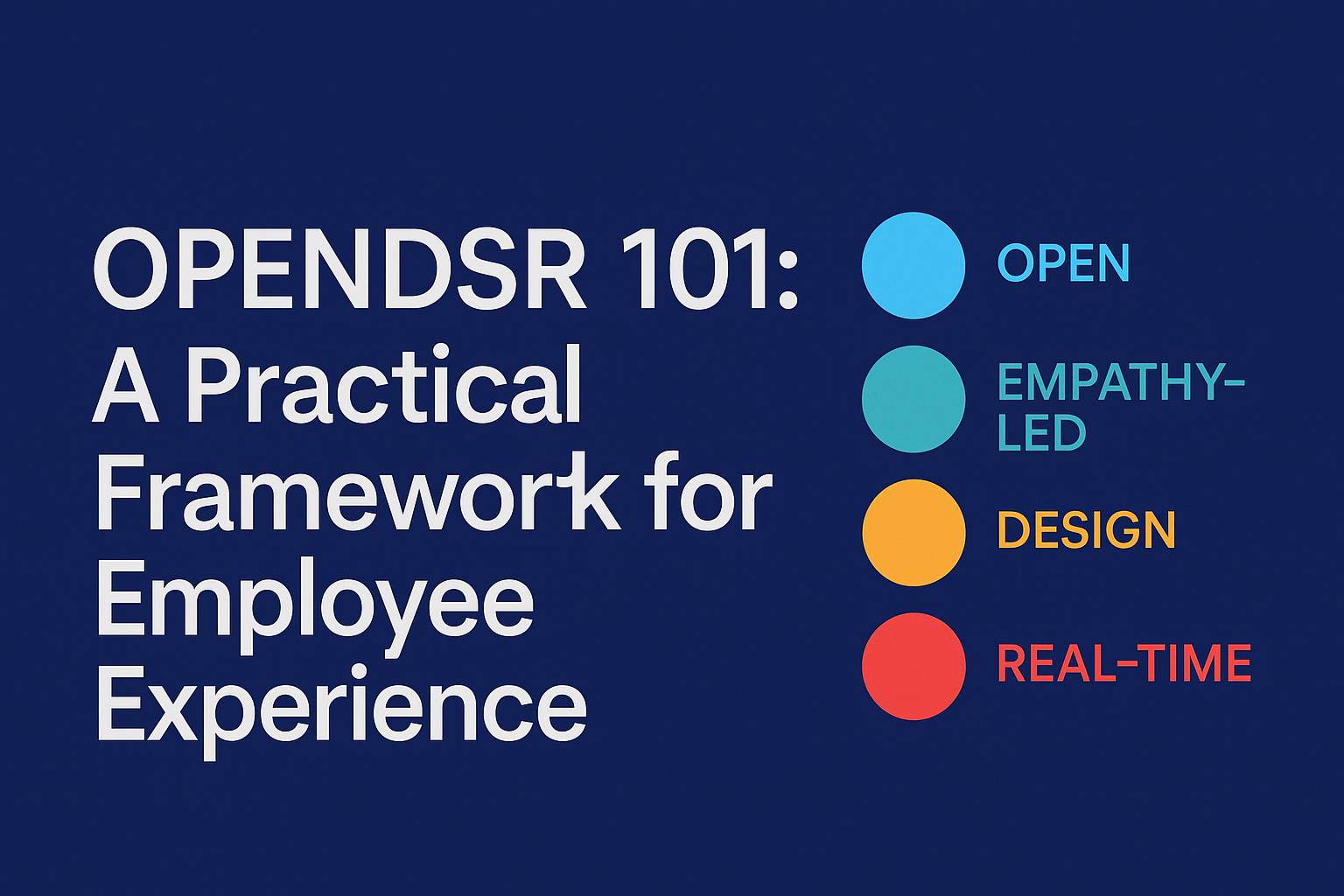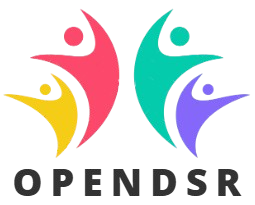
OPENDSR 101: A Practical Framework for Employee Experience
Why Employee Experience Needs a Reset
Work has never been more complex. Hybrid schedules, AI-driven tools, shifting workforce expectations, and constant business disruption have created a workplace where the employee experience (EX) is often fragmented and misunderstood. Employees describe their organizations with words like “fine,” “confusing,” or “exhausting.” Rarely do you hear “valued” or “supported.”
Research confirms this gap. A 2023 McKinsey study found that 67% of employees feel unseen or unheard despite significant investments in engagement platforms. Gallup’s global data echoes the crisis: only 21% of employees feel strongly connected to their organization’s purpose.
The problem isn’t lack of effort. HR teams deploy surveys, managers host check-ins, and leadership launches culture initiatives. The problem is misalignment. Tools often replace conversations. Data gets collected but not acted upon. And signals of distress are noticed too late—if at all.
Enter OPENDSR—a structured yet flexible framework built to realign organizations with the reality of work today.
What Is OPENDSR?
OPENDSR stands for Open Platform for Empathy-led Navigation, Design Standards, and Real-Time Intelligence. It is more than an acronym. It is a practical operating system for employee experience.
Unlike engagement models of the past, OPENDSR is:
-
Open – It integrates with the tools people already use, like Teams, Slack, or HRIS.
-
Empathy-led – It prioritizes sensing what employees feel and need, not just what they report.
-
Standardized by design – It ensures inclusive, consistent practices across the organization.
-
Real-time – It transforms feedback into immediate action, closing loops visibly.
In short: OPENDSR is not a tool or survey platform. It’s a rhythm for how organizations listen, design, act, and improve—without losing the human element.
The Four Pillars of OPENDSR
At its core, OPENDSR rests on four interconnected pillars. Think of them as the infrastructure behind better experiences:
1. Open Platform – The Infrastructure of Flow
Most employees use 6–10 digital tools daily. Each additional login, survey link, or dashboard creates friction. OPENDSR insists on designing experiences within existing flows. A quick nudge inside Teams or a prompt embedded in Slack is far more powerful than asking employees to visit yet another portal.
Case Example: A healthcare firm increased survey response rates from 15% to 65% simply by embedding a one-line question in their daily Teams briefing. No new platform was launched—just better timing and integration.
2. Empathy-led Navigation – Seeing What Data Can’t Say
Data reveals patterns, but empathy reveals meaning. OPENDSR equips leaders to sense early, ask differently, and act visibly. Instead of waiting for annual surveys, leaders notice subtle cues: silence in Slack, a dip in energy during retros, or spikes in PTO requests.
Case Example: A manager ran a quick “How does work feel this week?” pulse after noticing tone shifts on Slack. The result uncovered overwhelm after two leaders left. Adjustments were made within a week—before performance dipped.
3. Design Standards – Consistency That Creates Belonging
Inconsistency breeds inequity. When some employees get structured onboarding while others get an improvised version, belonging suffers. OPENDSR’s design standards ensure baseline equity across all moments—whether it’s performance check-ins, exits, or recognition.
Case Example: A retail company standardized exit reflections through a simple template embedded in Slack. Participation tripled, and valuable insights revealed systemic scheduling issues that leadership could finally address.
4. Real-Time Intelligence – Act While It Still Matters
Collecting feedback isn’t enough; it must translate into timely action. OPENDSR emphasizes signal → insight → action loops. Data isn’t stored for quarterly reports—it is shared, discussed, and acted upon while it still matters.
Case Example: A regional sales team used OPENDSR’s “insight loop” to uncover that unclear targets—not lack of effort—were draining morale. Within 48 hours, clarity was restored, stress reduced, and performance rebounded.
The 7-Step OPENDSR Operating Cycle
The four pillars provide the foundation. But how do you use OPENDSR day-to-day? That’s where the 7-step operating cycle comes in—a repeatable rhythm for turning signals into sustainable change.
-
Observe 👀 : Sense before solving. Capture real signals in real time—tone, participation, silence, or short nudges.
-
Example: A digital agency used weekly “green/yellow/red” mood checks in Slack to uncover meeting fatigue.
-
-
Prioritize 🎯 : From data to decisions. Not every signal matters equally. Use frequency and impact to decide what to act on first.
-
Example: A SaaS company focused its 90-day plan on just two issues—onboarding and role clarity—rather than drowning in 1,200 data points.
-
-
Envision 🧠 : Co-design the future state. Employees aren’t just participants—they are co-creators.
-
Example: A manufacturing firm ran “experience labs” with frontline staff, which produced new recognition rituals and improved morale.
-
-
Navigate 🗺️ : Build implementation roadmaps. Clear owners, realistic sequencing, and transparent plans keep momentum alive.
-
Example: A retail chain embedded a feedback launch map in Notion. Completion soared to 94% in 45 days.
-
-
Design ✏️ : Translate intentions into consistent experiences. Templates, checklists, and standards make EX predictable and inclusive.
-
Example: Global engineering managers adopted an OPENDSR “Navigate 1:1” template, boosting confidence in performance conversations by 38%.
-
-
Systematize ⚙️ : Make change routine, not reliant on heroes. Embed experiences into systems, platforms, and rituals.
-
Example: A fintech firm automated inclusive meeting protocols into Teams invites. Within 3 months, 82% of meetings followed the rhythm.
-
-
Refine 🔄 : Learn in motion. Iterate continuously, close loops visibly, and adapt without waiting for annual reviews.
-
Example: A services firm ran weekly “listening Fridays.” A simple insight—Tuesdays were most stressful—led to fewer Tuesday meetings and improved well-being scores.
-
This cycle transforms EX from sporadic projects into a living rhythm.
Governance Without Bureaucracy
One risk with any framework is over-engineering. OPENDSR addresses this through lightweight governance designed for care, not control.
-
EX Owner – Steward of experience integrity across the organization.
-
HCX Data Steward – Translator of signals into insights without overwhelming people.
-
Moment Designer – Architect of everyday rituals (onboarding, recognition, exits).
Together, they maintain rhythm through quarterly reviews—a sense-making space that blends empathy with evidence. Metrics focus on what matters most: sentiment, friction, flow, and closed feedback loops.
Implementation - Start Small, Scale Fast
OPENDSR isn’t about launching a massive transformation on Day 1. It’s about piloting one meaningful moment, learning fast, and scaling with confidence.
Steps for a pilot:
-
Choose a moment with high friction (e.g., onboarding, return from parental leave).
-
Map the current flow and pain points.
-
Co-design a minimal new flow with real employees.
-
Run a 4-week test with nudges and embedded templates.
-
Review and iterate before scaling.
Case Example: A consumer goods company piloted OPENDSR in one marketing team. Within 30 days, 81% of employees reported clearer growth conversations. Six weeks later, the practice spread to three more regions.
Common Pitfalls to Avoid
-
Starting with tools instead of truths – Technology won’t fix EX without empathy.
-
Waiting for perfection before launching – Pilot early, iterate openly.
-
Treating feedback as one-way – Always close loops visibly.
-
Overloading champions – Protect and support the change agents.
-
Measuring too much, too soon – Start with four indicators: sentiment, friction, flow, engagement.
Why OPENDSR Matters Now
The future of work is not a distant vision—it’s being designed every day, in every interaction. Employees are not asking for more dashboards or grand culture programs. They’re asking for clarity, trust, and care.
OPENDSR provides a practical way to operationalize empathy. It reframes empathy as infrastructure, design as inclusion, and intelligence as shared rhythm.
When applied well, organizations see:
-
Faster closure of feedback loops
-
Improved equity across regions and roles
-
Managers more comfortable with emotional conversations
-
Reduced attrition and higher trust scores
-
Cultures where employees feel supported through both highs and lows
OPENDSR 101 isn’t a theoretical exercise. It’s a practical, lived framework. It helps organizations move from collection to co-creation, from dashboards to dialogue, from intentions to impact.
The most powerful part of OPENDSR is its rhythm. Observe, prioritize, envision, navigate, design, systematize, refine. Repeat. Every quarter, every project, every team.
Because employee experience isn’t a side project. It is the operating system of modern work. And OPENDSR gives leaders the blueprint to make it real.








